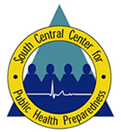
Biological Response Preparedness for Emergency Medical Services
Course Description:
This course is offered to better prepare the emergency medical services, public health officials and other first responder agencies, including law enforcement officers, for an incident involving Weapons of Mass Destruction (WMD). A special emphasis is placed on biological response preparedness for emergency medical services, including an overview on both trauma and chemical injury triage using the nationally recognized Simple Triage and Rapid Treatment (START) system. Course participants will be better prepared to use response information sources such as the FEMA’s Emergency Response to Terrorism Job Aid to assess WMD casualties, conduct medical triage, select the proper tactical response objective, and identify proper mass decontamination procedures. Participants will also receive an introduction to the Incident Management System and how to respond to WMD events using a unified command structure.
Target Audience
Academic Faculty/Staff, Federal Government Employees, State Government Employees, Local Government Employees, Non-Government Employees and Students
Learning Objectives
- Define terrorism, and recognize the chief characteristics of terrorist activities
- Recognize attack vulnerability factors and identify chief characteristics of the 5 categories of potential terrorist threats and implement self-protection measures
- Recognize delayed effects of biological agents compared to acute effects of chemical exposures
- Identify tactical considerations associated with acts of terrorism involving biological, nuclear, incendiary, chemical, and explosive materials (B-NICE)
- Identify the signs and symptoms of illness and/or injuries resulting from the WMD agents
- Recognize the difference in procedures and environmental concerns between technical decontamination and medical mass decontamination
- Identify the proper procedures involved in performing mass causality triage
- Recognize the chief indicators of a crime scene at WMD incidents
- Identify specialized equipment needed to support the tactical operations involving weapons of mass destruction
- Describe the purpose, needs, benefits and elements of a unified incident management system
- Identify the safe protection zones at WMD incidents
Instructor:

Sam Hansen
Battalion Chief, Vestavia Hills Fire Department, Vestavia Hills, Alabama
Available Credit
- 4.00 Participation/CETulane Professional and Continuing Education (PaCE) awards 4.00 hour(s) of credit for completing Biological Response Preparedness for Emergency Medical Services
Price
Required Hardware/software
System Settings
This course is designed to work most effectively if your computer and internet connection meet certain minimal requirements. This course can be accessed using a Windows 10 PC or a Mac with High Sierra1, Mojave, or Catalina. Pop-up blockers should be disabled when viewing the course. Internet Explorer 11 (for Windows 10), or the current version of Google Chrome, Mozilla Firefox, or Apple Safari (for Windows 10 and or Mac) is required. Many of our courses require Java and JavaScript enabled.
Links to External Websites
Links to websites outside this course will open in a new window or tab. Some browsers may minimize the course window. If this occurs, maximize the course window to return to the course.
Adobe Acrobat Reader (for desktops and laptops)
Adobe Acrobat Reader is required to access some documents in this course. If you need to download a free copy of Acrobat Reader, click here.
Internet Connection Speed
A minimum download speed of 1.5 Mbps is recommended for an optimal experience, which is commonly the speed associated with a basic DSL or a cellular/satellite connection. A faster connection, such as cable or fiber service, with further enhance your online experience. A Wi-Fi connection is generally acceptable, but it is dependent upon one of the two services mentioned above. You can check your internet connection speed at http://www.speedtest.net/.

 Facebook
Facebook Twitter
Twitter LinkedIn
LinkedIn Forward
Forward